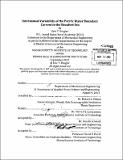Interannual variability of the Pacific water boundary current in the Beaufort Sea
Author(s)
Brugler, Eric T
DownloadFull printable version (17.45Mb)
Other Contributors
Woods Hole Oceanographic Institution.
Terms of use
Metadata
Show full item recordAbstract
Between 2002 and 2011 a single mooring was maintained in the core of the Pacific Water boundary current in the Alaskan Beaufort Sea near 152° W. Using velocity and hydrographic data from six year-long deployments during this time period, we examine the interannual variability of the current. It is found that the volume, heat, and freshwater transport have all decreased drastically over the decade, by more than 80%. The most striking changes have occurred during the summer months. Using a combination of weather station data, atmospheric reanalysis fields, and concurrent shipboard and mooring data from the Chukchi Sea, we investigate the physical drivers responsible for these changes. It is demonstrated that an increase in summertime easterly winds along the Beaufort slope is the primary reason for the drop in transport. The intensification of the local winds has in turn been driven by a strengthening of the summer Beaufort High in conjunction with a deepening of the summer Aleutian Low. Since the fluxes of mass, heat, and freshwater through Bering Strait have increased over the same time period, this raises the question as to the fate of the Pacific water during recent years and its impacts. We present evidence that more heat has been fluxed directly into the interior basin from Barrow Canyon rather than entering the Beaufort shelfbreak jet, and this is responsible for a significant portion of the increased ice melt in the Pacific sector of the Arctic Ocean.
Description
Thesis: S.M., Joint Program in Applied Ocean Science and Engineering (Massachusetts Institute of Technology, Department of Mechanical Engineering; and the Woods Hole Oceanographic Institution), 2013. Includes bibliographical references (pages 133-141).
Date issued
2013Department
Joint Program in Applied Ocean Physics and Engineering; Woods Hole Oceanographic Institution; Massachusetts Institute of Technology. Department of Mechanical EngineeringPublisher
Massachusetts Institute of Technology
Keywords
Joint Program in Applied Ocean Science and Engineering., Mechanical Engineering., Woods Hole Oceanographic Institution.